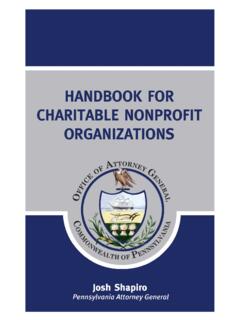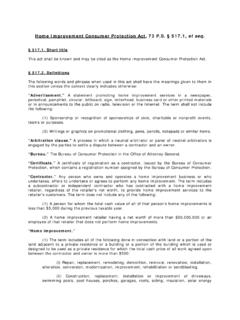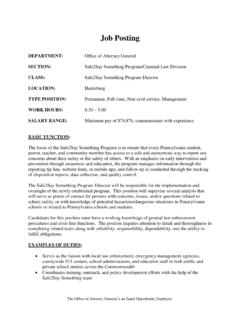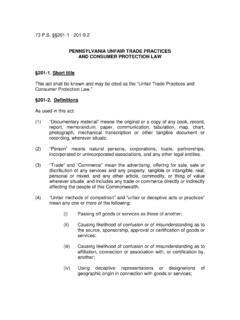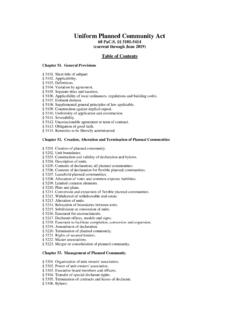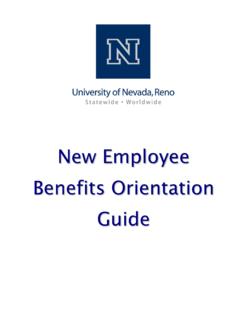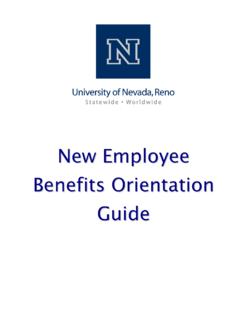Transcription of NEW EMPLOYEE BENEFITS SUMMARY BOOKLET
1 OFFICE OF ATTORNEY GENERAL COMMONWEALTH OF PENNSYLVANIA NEW EMPLOYEE BENEFITS SUMMARY BOOKLET REVISED JANUARY 2019 HUMAN RESOURCES SECTION 14TH FLOOR, STRAWBERRY SQUARE, HARRISBURG Important Notice: This BOOKLET is a SUMMARY of BENEFITS available to Commonwealth of Pennsylvania employees. It is not an agreement between the commonwealth and any EMPLOYEE . BENEFITS details are contained in state statutes, collective bargaining agreements, management directives, and contracts with various benefit providers and plan documents. If information in this BOOKLET differs from those documents, the official documents govern. 2 Medical Plan Options, Coverage, and Contributions (Active EMPLOYEE Health Plan administered by the Pennsylvania Employees Benefit Trust Fund [PEBTF]): Preferred Provider Organization (PPO) Choice PPO (Aetna) or Basic PPO (Highmark) o Allows the member to receive care from any in-network physician or facility. Primary Care Physicians and referrals are not needed.
2 O Choice PPO annual deductible of $400 single/$800 family Additional biweekly cost (in addition to percentage listed below) $ single/$ family o Basic PPO annual deductible of $1,500 single/$3,000 family o Deductible only applies to specific services (x-rays, surgery, blood draws at a facility other than Quest or LabCorp, etc.) o Regular and specialist doctor visits are only subject to co-pay o Co-pays $20 PCP; $45 Specialist; $50 Urgent Care; $200 ER (waived if admitted) o Out-of-network providers can be used, but fees are subject to the annual deductible before any plan payments will be made. Health Maintenance Organization (HMO) PEBTF Custom HMO (Aetna or Geisinger, depending on county of residence) o A Primary Care Physician (PCP) must be selected. The HMO requires that the member obtain a referral from a PCP before receiving care from an in-network specialist. o No in-network deductibles. o Co-pays - $5 PCP; $10 Specialist; $50 Urgent Care; $150 ER (waived if admitted) o Out-of-network BENEFITS are not available.
3 Employees may enroll effective on their first day of employment. Employees enrolled in coverage contribute a percentage of their biweekly gross base salary toward medical and supplemental BENEFITS , no matter what plan is chosen. Employees may participate in the Get Healthy program to reduce the percentage of their biweekly gross base salary which is paid each pay period. o January 1, 2019 through June 30, 2019 with Get Healthy waiver 5% without Get Healthy waiver For the first six months, employees may add dependents at an additional biweekly cost. o PEBTF Custom HMO $ o Choice PPO and Basic PPO $ 3 After six months, the dependent buy-up is removed. For example, an EMPLOYEE starting on February 25, 2019, would no longer pay the dependent buy-up effective on August 25, 2019. If a spouse or domestic partner is eligible for medical coverage through his/her employer, he/she must take that coverage as primary coverage. He/she can be covered on the EMPLOYEE s plan as secondary coverage.
4 Employees may enroll and add dependents at any time. There is an open enrollment period held in the fall, when changes can be made to an EMPLOYEE s plan, dependents can be removed, or coverage may be declined without a qualifying event. The changes would take effect on January 1st of the following year. Each plan is supported by DMEnsion, a company that provides durable medical equipment such as prosthetics, orthotics, crutches, wheelchairs, oxygen, etc. This is automatically included in the medical coverage and there is no need for a separate enrollment to receive these BENEFITS . Optum provides mental health and substance abuse treatment services to all employees enrolled in medical coverage. 4 Prescription Drug Coverage (CVS Caremark): Although the coverage is through CVS Caremark, other in-network pharmacies may be used. For the first six months, prescription drug coverage can be purchased at an additional biweekly cost. o $ single coverage o $ family coverage After six months, the buy-up is removed and the coverage cost is included in the medical coverage cost.
5 Coverage is based on a three-tier plan that uses a list of generic and brand name drugs to determine the co-pay. o 2019 Costs Retail 30 Days Generic $15 Preferred Brand $40* Non-Preferred Brand $80* CVS & Mail Order 90 Days Generic $ Preferred Brand $60* Non-Preferred Brand $120* Rite Aid 90 Days Generic $30 Preferred Brand $80* Non-Preferred Brand $160* o *Plus cost difference between brand and generic 5 Supplemental Health BENEFITS : Provided at no extra cost after six months of employment. Dental (United Concordia [UCCI] Advantage Plus Network) o The plan pays for up to $1,000 of dental work per person per calendar year with participating providers. o It covers 100% of diagnostic services and preventive care with no co-payment. There will be more savings in out-of-pocket costs when a participating dentist is used. o Basic work ( , fillings and root canals) is typically covered at 90% after a $50 deductible.
6 Major work ( , crowns and dentures) typically is covered at 60% after a $50 deductible. o Orthodontic lifetime maximum is $1,250 per person. Vision (National Vision Administrators [NVA]) o BENEFITS cover one routine eye exam and glaucoma test every 365 days with participating providers. o The plan also provides the EMPLOYEE and his/her enrolled dependents with an allowance for lenses and frames or contact lenses every 24 months (730 days); children up to age 16 may receive lenses every 12 months (365 days). Hearing Aid (PEBTF) o The plan covers one hearing aid per ear every 36 months (1,095 days). o Monaural hearing aids are covered up to $900. o Binaural hearing aids are covered up to $1,800. o BiCROS and CROS hearing aids are covered up to $2,400. Insurance cards will be mailed for each benefit, with the exception of the hearing aid. If the cards are not received within 30 days of enrollment, contact the PEBTF directly at 1-800-522-7279. State EMPLOYEE Assistance Program: The State EMPLOYEE Assistance Program (SEAP) is a free, confidential assessment and referral service available to you and your family 24/7 to help you deal with emotional or family concerns, alcohol or drug abuse, depression and other behavioral health matters, or financial and legal issues.
7 The majority of commonwealth employees are eligible for SEAP. You are eligible for SEAP from your first day of employment, whether or not you enroll in medical coverage. To access SEAP services, call 6 Retirement (State Employees Retirement System [SERS]): Enrollment into a plan is mandatory and automatic. If you were previously a member of SERS, you will be enrolled into the same plan. SERS members prior to January 1, 2011, contribute of their gross biweekly salary (pre-tax). SERS members from January 1, 2011, through December 31, 2018, contribution rates are below: o A3 contribution rate 2% benefit accrual rate o A4 contribution rate benefit accrual rate o Employees in A3 or A4 classes are vested after 10 years of service, or 3 years of service after reaching normal retirement age (55 for criminal law agents or 65 for all other employees). o All new law enforcement employees will be placed in the A3 or A4 class and are not subject to the new plans listed below.
8 SERS non-law enforcement members starting after January 1, 2019, will have three plans to choose from: o A5 Hybrid plan defined benefit + defined contribution contribution rate benefit accrual rate o A6 Hybrid plan defined benefit + defined contribution contribution rate 1% benefit accrual rate o Employees in A5 or A6 classes are vested after 10 years of service, or 3 years of service after reaching normal retirement age of 67 o Straight Defined Contribution Plan contribution rate No retirement benefit No vesting Can cash out at retirement/separation Employees will receive additional information on the retirement plans in the mail at home about a week after their start date, which will include the enrollment form for an alternative retirement plan selection. 7 Deferred Compensation (Empower Retirement): The commonwealth also makes it easy for you to voluntarily set aside more money for retirement. The State Employees Retirement System manages a program that allows you to have some of your pay automatically deducted and invested in a variety of investment options.
9 You select the amount you want to invest, as long as it is at least $5 per pay and not more than the annual IRS limit. And you decide which of the available funds to invest in there are aggressive, moderate and conservative risk profile options along with many other choices. Your deferred compensation account has certain tax advantages as outlined in 457(b) of the federal tax code. Since deductions are taken on a pretax basis, you save money because you are not paying federal income tax on your deductions. Or, if you prefer, you can choose the Roth 457 option. You pay taxes now, but do not pay taxes on the gains when you retire. To get more information or to enroll in the deferred compensation program, contact the plan administrator, Empower Retirement at Learn more at 8 Life Insurance: Commonwealth-Provided Life Insurance (MetLife) o Automatically enrolled after 90 days of employment at no cost to you. o In the event of your death, your beneficiaries will receive a sum equal to your annual salary (rounded to the nearest $1,000), up to $40,000.
10 O You will receive a packet in the mail from MetLife that includes detailed information about the coverage, as well as how to elect your beneficiaries. You can designate your beneficiaries online or by mail after your coverage effective date. o For more information, contact MetLife directly at 1-855-972-5433 or visit Optional Life Insurance (Prudential) o You can buy additional life insurance for yourself or your dependents with convenient payroll deductions. A group rate has been negotiated with Prudential for you to buy up to five times your annual salary to be paid to your selected beneficiary. Prudential will send an informational packet to your home, which includes details about purchasing coverage for your spouse/domestic partner and children. o You must enroll in this coverage within 60 days of starting work or wait until an annual open enrollment period. You can enroll by calling Prudential at or by visiting Optional Disability (Prudential) o Prudential offers a group rate for long-term disability insurance to commonwealth employees who authorize payroll deductions.
